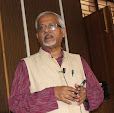Tuesday, October 16, 2007
The lion of Durga is a gift from a Greek goddess
Arindam Roy
Merinews 11 October 2007, Thursday
Durga was created by the powers of Brahma, Vishnu and Shiva. They opened their third eye and she was born. Various gods decorated her with weapons. A Greek goddess’ gift was forgotten, it seems. A report on the evolution of Durga iconography.
THE WHITE LION of Mahisasur-mardini (Durga) has been imported from Greece. The lion, as a vehicle, was incorporated in the Durga iconography between sixth century AD and 12th century AD. It was ‘imported’ from (read, gifted by) the Greek goddess, Nanaia.
We find occasional representation of Nanaia riding a lion on some Kushan coins and seals. Historians point out that on the basis of the development of the Durga iconography, it might be said that the prominence of the war-goddess grew in 700 years.
In the early Kushan period, around first century AD, Durga was a lesser goddess. The terracotta figurines and stone sculptures of this period depict the goddess with two or four hands, wrestling with the demon (Mahisasur), locked in hand to hand combat. Most of these figurines and sculptures were excavated at a site called Sonkh, near Mathura. It forms a rich legacy of the Mathura Art. For 300 odd years, during the Kushan period, the lion is not seen.
"The Mahisasur-mardini icon of goddess Durga, as we see it today, evolved in the Gupta period, undergoing changes in iconography. Around this time, we find examples of Devi with eight, 10, 12 and even 16 hands. As her stature grew, her iconography evolved," informed Dr Sriranjan Shukla, the assistant keeper of Allahabad Museum, in an exclusive interview.
Durga is the most widely worshipped aspect of Shakti, till today.
The Gupta period is a time of transition. Referring to a sandstone relief, of the latter part of the fifth century AD, of a Chandrasala (which were placed outside temples to indicate the ruling deity), we see Mahisasur-mardini combating the asura (demon). It shows the goddess place one of her feet contemptuously on the head of the vanquished demon. She lifts his hindquarters by the tail and pins him down with her Trishul (trident). A short male figure, as her attendant, establishes her glory. He is a gana of Shiva, consort of the goddess. The locks of the gana and the goddess are elaborately treated, in the style of that period.
The Kushan artists of the Mathura Art School are credited to conceptualize Mahisasur-mardini, or the form of Durga defeating the buffalo-demon. From a lesser goddess, depicted in terracotta figurines and sandstone relief, she attained glory in the Gupta period. Most of the Puranas were authored in the Gupta period, which was a golden era of Indian art, literature, trade, commerce and polity. It was a time of peace and prosperity.
Shukla explained, "The sculpture of the Gupta period is marked by serenity, poise and calm, which is reflected in the face and postures of the images. There are few ornaments. The divine beings are comfortable disposition, as they are in Lalit-asana and Sukha-asana. There is liveliness and energy in the art of this period. Even the standing images are not static. For example, a standing image of Lord Buddha, show a foot raised, knee bent, moving forward. This was the spirit of this era."
Dr Sunil Gupta, an art-historian, said, "It was probably in Gupta period, between fourth century AD and sixth century AD that Durga icon was introduced in Bengal. The worship of the female principle is reflected in popular terracotta art, since ancient times, in Bengal. I have seen the famous mother goddess figurines, in terracotta, from the ancient port of Tamralipti (presently, Tamlute, in Midnapore district, West Bengal) in the Ashmoleon Museum, Oxford. This is from the first century AD, and the icon is not that of Durga. It was only natural for the people of the eastern state to accept Durga and assimilate it in their lifestyle."
Swami Harshananda, of Ramkrishna Math, in his book, ‘Hindu Gods and Goddesses’, says, "Lion, the royal beast, her mount, represents the best in animal creation. It can also represent the greed for food, and hence the greed for other objects of enjoyment which inevitably leads to lust. To become divine (Devatva) one should keep one’s animal instinct under complete control. This seems to be the lesson we can draw from the picture of the Simhavahini (the rider of the lion)."
(Link: http://goddesschess.blogspot.com/2007/10/lion-of-goddess-durga.html )
---
PHOTO CAPTION: A rare image of Mahishamardini Durga from the 5th AC found at Chadrashala, M.P. Preserved at Allahabad Museum
PHOTO CREDIT: Bhaswati Bhattacharya
Currency of Songs
7 months ago













Goddess Durga represents the power of the Supreme Being that preserves moral order and righteousness in the creation. The Sanskrit word Durga means a fort or a place that is protected and thus difficult to reach. Durga, also called Divine Mother, protects mankind from evil and misery by destroying evil forces such as selfishness, jealousy, prejudice, hatred, anger, and ego.
ReplyDeleteDurga, Durga ma pics, Goddess Durga, Durga Photo, Durga Puja, Durga ma picture, Durga Mata